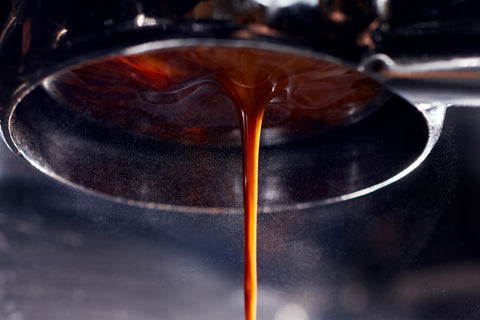If you are brewing espresso at home, you have probably heard the term ‘Dialling-in’ across the internet or even in your local cafe. But what is ‘dialing-in’ and why is it so important? Let’s take a look.
What is Dialling-in?
Dialling-in is the term used to describe the process of creating a recipe to produce a perfect flavour balance in your espresso when controlling several variables. Think of it the same way as following a recipe when cooking, except instead of following, it’s your job to come up with the recipe, allowing you the freedom to tweak it for improvements and for consistency.
In a cafe setting, dialling-in is extremely important as it directly affects consistency, allowing the barista to accurately produce great tasting espresso over and over again. At home this is slightly trickier, as ideally you want to minimise the amount of waste you produce. But that doesn’t mean that you can’t produce great tasting espresso. Below we’ll outline a quick and easy way to dial-in at home.

How to Dial-in at home
When dialling-in we focus on three main variables that affect flavour. These variables are Dry Dose, Wet Yield and Extraction Time.
Dry Dose: This is the weight of ground coffee you use at the beginning of the process.
Wet Yield: This is the amount of espresso that is extracted into your cup.
Extraction Time:This is the amount of time it takes your espresso to pour.
When creating an espresso recipe it is generally suggested that you should aim for a 1:2 brew ration between your dry dose and wet yield. With that in mind, here is an example of what an espresso recipe might look like and a great starting point for any recipe.
18g (Dry Dose) - 36g (Wet Yield) - 25 - 30s (Extraction time)
Adjusting the Grind Size

One of the easiest variables to adjust is brew time. This is controlled by adjusting the size of the coffee grind particles. Generally speaking, the coarser the grind size, the quicker the shot will be extracted. Most home espresso grinders use a number scale to represent the grind size, with the lowest number representing the finest point and the highest number representing the coarsest point.
To adjust the grind size, first you have to identify whether you wish the espresso shot to extract slower or quicker. If you have identified that you need your espresso shot to extract slower, start to lower the grind size, working your way down the numbers until you are happy with your extraction time. If you have identified that you need your espresso shot to extract quicker, increase your grind size, working your way up the numbers until you are happy with your extraction time. When adjusting the grind size, we would alway recommend making small adjustments as this will make it easier to fine tune your recipe.
Remember to purge a shot of espresso through your grinder and discard after making a change. This is to clear out any coffee retained under the burrs (grinder blades) that was ground on the older grind size setting, which if not done can lead to confusion in getting an accurate grind size adjustment.
Tamping

It is always important to ensure that you are tamping evenly. If your tamping is uneven, water will flow down the slope and go through one side of the puck more than the other. This will lead to an uneven extraction, which therefore leads to your espresso being unbalanced in flavour.
Distribution of ground coffee in portafilter:A simple hand tap on the handle until grounds fall evenly and distribute across the portafilter basket will increase the chances of an even extraction as there will be less dense and weak areas within the puck that could lead to channeling.
Channeling:Channeling occurs when the high pressure water from your espresso machine finds a narrow path through the coffee puck, instead of flowing through the entire puck evenly. This leads to an uneven extraction and the prominence of undesirable flavours. Great distribution is key to reducing the likelihood of channeling
Brew Temperature
Depending on what machine you have at home, you may be able to adjust the brew temperature to fine tune your espresso recipe. You should aim for your espresso machine temperature to be in the range of 90-96 degree for optimum espresso brewing. This is especially important if you like to experiment with different origins and roast profiles, as each coffee may react differently to temperature. We would recommend adjusting other variables such as grind size, dose, and espresso volume before playing around with your brew temperature. Or, if like us, you just love experimenting, adjust in small increments for the best results. Generally, your machine should be set to 90-92°C for dark, 93-94°C for medium and 95-96°C for light roasts as a great starting point.
Evaluating your espresso

Of course, the most important part of all this is taste. That’s the very reason we go through all this trouble. At this point you might be wondering what to look for when it comes to evaluating the taste of your espresso. Let’s take a look.
When dialling-in our main goal is to create an espresso that is well balanced, with great acidity, pleasant sweetness and minimal bitterness. When tasting there are two things that could lead to your espresso tasting unpleasant. These are under-extraction and over-extraction.
Under-extraction: This means that you have not extracted enough coffee from the grounds that are in your portafilter. Flavours that could indicate your espresso is under-extracted include, unpleasant acidity, grassy or vegetal notes and saltiness.
Over-extraction: This means that you have extracted too much from the grounds in your portafilter. Flavours that could indicate that you have over-extracted your espresso include excessive bitterness, lack of flavour clarity and a dry finish.
It is in the middle point between under-extraction and over-extraction where the espresso is at its optimum flavour. We always aim to hit that extraction target.
Now you know the basics, the best way to learn is to have a go!
We have loads of fantastic coffees for brewing espresso at home - SHOP COFFEE
Need an espresso machine? We’ve got you covered - SHOP ESPRESSO MACHINES
Want to stay up to date with all our latest news?
Sign up to our newsletter here.
